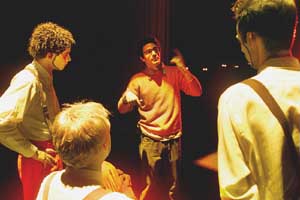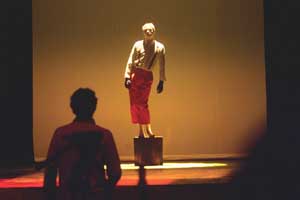Haunting Pierrot’s Ghost: UT, Fire Escape collaborate on feature film project shot on campus
By Carrie GolusNews Office
 Nima Bassiri, director and screenwriter of the film >Haunting Pierrot’s Ghost, directs cast members during film shooting in Mandel Hall. |
The age-old struggle between father and son, religious allegory, references to Marx and Hegel, and mimes––What else could one ask for in a feature film?
Haunting Pierrot’s Ghost, a collaborative project by University Theater and Fire Escape Productions, offers all this and more. The film, written and directed by alumnus Nima Bassiri (A.B., ’01), will make its debut at Doc Films at 9:30 p.m. Sunday, May 26.
The genre-defying Pierrot’s Ghost tells the story of Byron Delacroix (Brendan Donaldson), the son of a famous French mime artist who died when Byron was a baby. In the attempt to find out more about his father, Byron encounters Spectre, a mime troupe whose homeless, starving members survive in the basements of University buildings. Drawn into the culture of mime, Byron tries to resist by bringing the mimes out from underground and onto the stage––with unexpected, tragic results.
 |
Bassiri first came up with the idea for a collaborative UT-Fire Escape project last spring and proposed it to Jeff Sousa, Fire Escape’s incoming president. Though Bassiri had only the roughest idea for a storyline––“I didn’t even have the mime thing yet,” he said––Sousa was immediately interested.
Not wanting to write a script about “a guy and a girl and a dog,” Bassiri eventually settled on the idea of mime: “I don’t know of any movies about mime, except Children of Paradise from 1945,” he said. The fact that mime is so reviled also intrigued him. “Some of the mimes of the early 20th century, from which I was most inspired, were really heavily Marxist. It was revolutionary theater for them––a new style of theater that laid the groundwork for performance art. But then it fizzled out and became a joke. That interested me; at what point does a form die, become a shell?”
Even more intriguing, the hatred of mime seems to be an American phenomenon, he said. “Europeans don’t perceive mime in a negative way. Mime for them is a very important aspect of theater, a distinctly European theater. But in American culture it’s problematic––perhaps because of the lingering political tension associated with mime as a result of its heavily Marxist roots, perhaps because of the European connection it carries.”
Over the summer, Bassiri hashed out a rough script and even rougher storyboards, and pre-production began in the Fall Quarter. After an open casting call brought 300 headshots and 50 auditions but “no results,” Bassiri said, the film was cast with a combination of students, including fourth-year Eric Pogrelis and third-year Bryson Engelen; alumni, including Avram Klein (A.B., ’01) and Dan Stearns (A.B., ’91; A.M., ’93); and friends of friends.
By Winter Quarter, the group had not only won financial support from both UT and Fire Escape, but also a $10,000 grant from UChicagoArts. The film wrapped on Saturday, April 20––after an all-day shoot that required the closing of Blackstone Avenue between 57th and 58th streets––and is currently in the final stages of editing.
While Hyde Park and the University locations figure heavily in the film, viewers will not necessarily recognize what they see. Some scenes were shot in the crypt under Rockefeller Memorial Chapel and others in the old ballroom of the Shoreland Residence Hall. “It elicited images of a past greatness,” said fourth-year Tony Gannon, the project’s art director. “I don’t think I would have wanted to shoot in any other space on this campus or even Chicago.”
Unusually, Pierrot’s Ghost was partly shot on video, partly on film––a decision that ties in with one of the project’s main themes, the complicated relationship between father and son. “Video is like the son of film,” said Bassiri. “People say that video is cheaper, and eventually we won’t need film anymore. It’s just like a son saying: I won’t ever need my father anymore.”
This film/video relationship also is mirrored by a father/daughter relationship. The project’s main cinematographer, fourth-year Kristina Nikolova, is the daughter of two well-known Bulgarian cinematographers. While Kristina was responsible for shooting the basic narrative of the movie on video, her father, Georgi Nikolov, was flown in from Bulgaria to shoot the mime performances on film.
Both the video and film sections feature a “roaming camera,” Kristina explained. “The camera often pans away while an actor is still talking, looks around the space and pans back to the actor. This prepares the viewer for the film’s unexpected ending.”
None of the actors in the film had ever performed as mimes before, so they had to teach themselves “a vocabulary of movement we all could share,” said Engelen. While he does not plan to start performing in parks anytime soon, learning to use his body more expressively was a skill worth learning, he said: “I think mime is useful for the actor in training him how to convey an idea with the body, not just use the body to support the spoken word. There is a language of the body that is outside speech.”
The film’s opening at Doc is not so much a premiere as a test screening; the filmmakers plan to pass out surveys afterward to measure audience reaction. Eventually, they would like to submit Pierrot’s Ghost to student film festivals around the country.
“The project is really very Chicago, in that it’s so ambitious,” said Heidi Coleman, Director of UT and adviser to the group on its UChicagoArts grant application. “Anywhere else, the students might have been encouraged to scale it back, make a 10-minute short. But here, they’re not doing anything halfway.”
Bassiri, who was involved with both Fire Escape and UT as an undergraduate, credits UT with teaching him and many of the actors and crew members how to work so quickly. “UT is very rigorous. Two years ago, it was doing 30 shows a year. That’s a lot. So I thought, one project, over a year? No problem.”
![[Chronicle]](/images/small-header.gif)